#zohar metatron
Text

silhouette mirage lgtv live community headcanons
#art#fanart#procreate#doodle#i guess#shyna nera shyna#pablo#zohar metatron#armageddon#geluve#megido birthclod#hal birthclod#faust#delia#sara#silhouette mirage#i dont wanna properly finish this shit man…#aaaaaaaaa
16 notes
·
View notes
Text

zohar is so bigender swag
#silhouette mirage#shyna nera shyna#zohar#zohar metatron#zohar sandalphon#silhouette mirage spoilers#???????????????#ask to tag#my art
9 notes
·
View notes
Photo

Silhouette mirage art in my 2023???
1 note
·
View note
Text
My complete and unhinged Metatron analysis
Hello, I have seen that many people are theorizing about Metatron, so I'm here presenting an analysis of who Metatron is, rather his biblical role and how he may be more connected to the Aziraphale and Crowley than we might believe.
-Also, English is not my first language, so please be patient with me-
ANALYSIS OF METATRON AS A FIGURE WITHIN CHRISTIANITY:
Metatron, has always been a controversial figure in Christianity, full of dualisms.
Let's start with its etymologically. The term Metatron has two completely different translations: one comes from the Greek metradromos meaning "he who pursues with vengeance"; or it is also possible that its origin is from the term meta ton thronon which means "closer to the throne". There are many doubts about his true origin, since it is mentioned in non-canonical versions of the Bible, during Genesis*. However, in the most current and official versions of the Bible, it never appears.
While there is nothing official, the most accepted version is that he is actually the prophet Enoch, Noah's grandfather. Enoch -who used to have his own book of the Bible in earlier versions- was a prophet who had the God-given gift of visiting Heaven through different visions. In his 1st vision, Enoch has the mission to intercede with God on behalf of the fallen angels. In another vision, he sees the Cherubim in Heaven, whom he describes as beings of fire. Later, he is taken by the archangel Michael to the highest heaven. Enoch also travels in his visions or dreams to the tree of knowledge. He is supposed to have lived 365 years and, at the end of his visions, Enoch is chosen by God to become the archangel Metatron, a powerful archangel who is also called the little Yahweh.
There is another explanation for his origin: he is the first being of creation, seated at the left hand of the father, which in tradition is associated with Satan.
The Zohar also describes Metatron as "the king of angels" who reigns over the tree of the knowledge of good and evil.
When Enoch was on Earth, he devoted himself to writing a book containing the secrets of wisdom until he was taken to Heaven to become an angel. God allowed Enoch to continue this same ministry in Heaven** .

FUN FACTS:
Metatron was the one who led the Israelites to the Promised Land (Moses).
Metatron is the patron angel of children.
Metatron transmits God's daily orders to the angels Gabriel and Raphael.
Not being an angel from his origin, Metatron is associated with the angels in charge of Death, he supervises them when they help the souls to make their transition from the physical to the spiritual plane.
He is canonically the most powerful archangel in the entire celestial realm, second only to God. His role is similar to Lucifer's original rol, the right hand of God.
The archangel Metatron is in charge of directing the ascension and activation of the human being's light body. Having been human, he knows the path of enlightenment. He represents the potential for transformation and purification of the soul when it sets out to transcend matter to unite with the pure spirit of the Divine. Metatron is in charge of guiding the souls towards the light, towards purity (insert the fact that he asks for coffee with almonds, which in Christianity is related to purification).

METATRON IN THE LORE OF GOOD OMENS
It is worth mentioning that in the original Good Omens book, Metatron is the only angel that appears besides Aziraphale. While other angels are mentioned, Metatron is the only one who appears, firstly when Zira wants to talk to God, and secondly when Beelzebub and Metatron make presence at the Tadfield airbase to try to convince Adam to restart the end of the world (it is not Gabriel who appears in the book).
And, considering that the 3rd season is based on the sequel to the book that never came out, it makes sense that Metatron would have had a bigger role because he was always a present character.
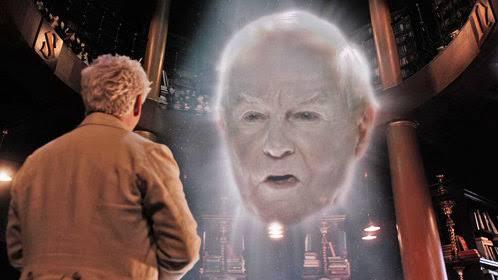
HIS RELATIONSHIP WITH CROWLEY AND ZIRA:
So, from all this information, I would like to point out that Metatron not only used to be human and knows the "true path of purification," but he is also in charge of caring the tree of knowledge.
You know, that tree?

Aziraphale and Crowley represent the two things that oppose his very existence: an angel that is becoming more and more human with each passing day and the Serpent of Temptation that keeps doubting and questioning the edges and the difference between good and evil.
These two not only were they not punished, but together they are two extremely powerful entities, perhaps as powerful as he is.
They are a threat… but only together.

Metatron can see in Aziraphale the very opposite of what he represents, someone who needs to return to the path of divinity:
Aziraphale, the supposed guardian of Eden, who started out as an angel, who gradually transformed into someone with more and more human habits, falling into almost all the deadly sins, in love with the Serpent who tempted humans to eat from the forbidden fruit of the tree of knowledge. Someone who loves forbidden books and bibles, with a hedonistic and condescending personality who managed to deceive his brother angels for millennia to protect humanity and his earthly life***.

It would also explain his disdain towards Crowley, why he looked at him with that face: Metatron is the protector of the tree that Crowley managed to corrupt.

To all this we can add that Metatron/Enoch renounced his humanity to become something superior, while Crowley and Aziraphale consider humanity to be something superior worth defending and loving. They see in humans what Enoch could not see behind his judgment of false celestial purity. They are two supernatural entities who managed to love humanity more than he, a human, ever could.
These parallels are not only born out of my obsession, no. The fact that Metatron has separated them has a much more possible and deep significance.
Narratively, this can only mean one thing: Metatron is the villain, the perfect antagonist to Aziracrow.

CLARIFICATIONS
*Genesis is where the Adam and Eve story is found, the Garden of Eden, the moment that changes Zira and Crowley forever….
**That "book that contained the secrets of wisdom"… is it the book of life? Is Metatron the only one who has access to it?
***I would like to clarify, that for me the real main character of Good Omens is Aziraphale, that's why I find more comparisons with him, followed by Crowley as co-protagonist, but I will continue this theory another day.
#good omens#ineffable husbands#aziracrow#did i just also make a whole bible analysis? Look what you made me do gaiman#can this be tagged as a bible study?#bible study#every time i see a catholic metatron figure i want to throw up#neil gaiman#terry pratchett#good omen season 2#good omens theory#good omens metatron#go2#aziraphale#crowley#good omen 2 spoilers
153 notes
·
View notes
Text
Good Omens Season 3: The Nice and Accurate Prophecies of Sectumsempress1, Hag
I am once again going through my Good Omens season 3 predictions bingo and explaining why I think the things I think. Today I want to talk about Metatron's memory meddling, or more specifically why I think Aziraphale is the Archangel Raphael and why I don't think he remembers.

Once again, I know I cannot be the first person to think of this theory. I'm just adding my two cents. Here we go.
I know there is a fairly popular theory that Crowley was Raphael before the fall, but putting aside the fact that it simply wouldn’t work for television to give them a name that similar to Aziraphale, I just disagree with that assessment. I like to think that Crowley was Jophiel before they fell and Aziraphale’s original name was Raphael.
I think we can answer this theory very quickly by noting that in The Book of Tobit, Raphael disguises himself as a human on earth, acting as a healer and guardian under the name Azariah. I honestly just think that Neil and Terry took the name Raphael and his human name Azariah and landed on Aziraphale.
Furthermore, Raphael (“God has healed”) is literally the archangel of healing. He is also known as the angel of protection and keeping people safe on their journeys. God gives Raphael a mission in The Book of Enoch, verse 10:10 to:
“Restore the earth, which the [fallen] angels have corrupted; and announce life to it, that I may revive it.”
Aka ‘thwarting evil wiles.’ In The Zohar it’s also stated in Genesis chapter 23 that he:
“is appointed to heal the earth of its evil and affliction and the maladies of mankind.”
If I were to go over every single instance of Aziraphale fitting the bill for these descriptions I would be here all day, but some I can think of off the top of my head are:
Giving Adam and Eve the flaming sword to assist them on their journey
Healing Anathema’s broken arm and bike
“Actually, I encourage humans to do the actual- [thwarting of evil wiles]”
Fixing that man’s phone in the graveyard in Scotland
Insisting that he wants to heal wee Morag
Protecting ‘Jim’
This stunning scene in the Job memory:

He is very clearly shown as a healer, protector and guardian of humanity, more so than any other character.
Raphael is also known as a matchmaker, which is funny when you think about the Nina and Maggie situation but also makes total sense. Aziraphale loves love. Also he blows the trumpet to announce the Day of Judgement, aka the second coming. I guess Metatron needs Raphael back now huh? He even told Aziraphale himself that he is the only one qualified for this job. Aziraphale is Raphael.
Or… he was.
I believe that Raphael was demoted following the fall, and Gabriel’s story is meant to mirror his. This scene says SO much:
“You have refused to exercise your celestial authority, and are henceforth removed from office”
I think something similar absolutely could have happened to Raphael. We all saw how immediately drawn Aziraphale was to Crowley in ‘before the beginning,’ and it makes sense that Metatron could have seen that connection as a liability when he fell. He cannot have an Archangel in Heaven who is sympathetic to one of the fallen, it would be a ticking time bomb for another revolution. Aziraphale being sympathetic towards Angel!Crowley before and during the fall would make him question the fall as a concept, and Heaven could not afford that.
“For one Prince of Heaven to be cast into the outer darkness makes a good story, for it to happen twice makes it look like there is some kind of institutional problem.”
I think the first prince of Heaven Metatron is referencing to is Crowley, and I think he had this same mindset of making sure there was no perceived institutional problem during the time of the fall. So I think that is one of the reasons why Raphael wasn’t cast down; it would look bad. I think the other reason is; Metatron wanted him and Crowley separated, even then. Even then there was some glimmer of their potential combined power, the love and danger that could be born by having them both in the same place with neither of them on Heaven’s side. The most logical option would be to cast Crowley out and make Aziraphale think he deserved it. Because Metatron is smart. He knew that keeping an angel like Crowley in Heaven—an angel who unapologetically asked questions and wasn’t afraid to go against the status quo, even before he fell—could only end badly. The smart move was to keep an angel like Aziraphale on—an angel who wants to believe, who needs to believe, that heaven is fundamentally right and good—and feed into his faith by manipulating his fear.
(Editing to add- it’s presented as an either or. We will not send you to hell, we will wipe your memory and demote you. We will do A or B. This is why I think Gabriel’s story mirrors Aziraphale’s more than Crowley’s, because being cast down to hell and having your memory wiped was never on the table here. It’s either or.)
“Although as a kindness, your memory of your time as Gabriel will be erased. You will be demoted.”
“As a kindness, your memory of your time as Raphael will be erased. You won’t remember the Starmaker, you won’t remember the fall, you won’t remember the injustice. All you will remember is the war, the divine plan, God’s will and your undying faith to carry out that will. You will remember what not doing so costs, but you will never remember why. All you’ll remember is that you had better not ask, because look where that got the others. Oh, and you will be demoted to earth. You will not remember the incredible power you wield as an Archangel. Because if you hand power like that to someone with a powder keg of repressed questions it may spark an explosion, and we cannot afford that. Not again, Aziraphale.”
Now I want to talk about two specific scenes that relate heavily to this theory.
Before The Beginning
I think this memory has been altered, and there are two ways of looking at it.
Aziraphale remembers it just as shown on screen.
But in Eden he genuinely seems as though he is meeting Crowley for the first time, and then when he introduces himself as ‘Crawley,’ Aziraphale consistently messes up and calls him that even after he changes it to Crowley. So I can deduce from that that if Aziraphale had known Crowley by another name for millennia before Eden he would very much struggle with remembering to call him Crawley to begin with. The fact that he doesn’t struggle at all makes me think that it truly is his first time learning this person's name, his first time meeting them.
Aziraphale does not remember this moment, it’s only shown to the audience for a season 3 payoff.
But during the confession, Aziraphale says “like the old times, only even nicer.” re: Crowley becoming an angel again, which implies that Aziraphale remembers ‘the old times’ with him. He also says “I know the angel you were” during the Job scene.
We are at a bit of a dead end here… or are we? A possible solution is that Aziraphale does remember ‘before the beginning,’ but that memory has been altered to remove Crowley’s involvement, à la Frozen (“I recommend we remove all magic, even memories of magic, to be safe… but don’t worry, I’ll leave the fun.”) The ‘magic’ in this instance being anything that would paint Crowley in a sympathetic light and the ‘fun’ being the actual events that transpired. That would also explain why he remembers it the way he does, aka why Crowley’s angel name is omitted and why he introduces himself as Aziraphale and not Raphael, but he still recalls the actual string of events. Because Aziraphale can’t just have large gaps in his memory. He has to actually remember the cold hard facts. Metatron is far too refined of a villain to leave holes in his soldiers’ minds, especially giant star-shaped love holes. Where was I going with this? Okay anyway…
So when Aziraphale says “like the old times, even nicer” he is not specifically referencing the Starmaker scene, but instead a more general ‘memory’ of Heavenly life, which makes total sense considering Aziraphale’s apparent blindness to the true detailed atrocities of Heaven. All he sees is the big picture anyway, that’s all he’s ever seen. Because… ‘even nicer’ ??? What do you mean NICER? A bureaucratic job will be nicer than watching the being you love build a universe?? Okay.
Same goes for “I know the angel you were” from the Job scene. The wording is important here. He didn’t say “I knew the angel you were” or “I knew you in heaven.” It feels like he is a step away from saying “I know of the angel you were.” Which, in the context, makes sense. He is trying to use a personal plea as a last-ditch attempt to get Crowley to do what he thinks is right, he is not reminiscing on their time as besties. He’s already cycled through:
“You don’t have to do this!”
“You have free will!”
“I don’t think God wants this!”
“I don’t really think you want to either!”
And when Crowley asks “what do you know about what I want?” in that bitter tone, Aziraphale reads it as an in. He thinks a personal plea may be the thing to get Crowley to stop, so he uses it. It’s a tactic.
With all that in mind, I believe ‘before the beginning’ to be an altered memory. I believe that Aziraphale remembers the creation of the universe in general terms but does not remember the Starmaker or the feelings that were already beginning to take root inside of him.
In The Beginning
I believe this to be an authentic memory, and if you look hard enough (aka are delusional and also insane) there are clues to support my ‘Aziraphale doesn’t remember' theory, starting with their first meeting.
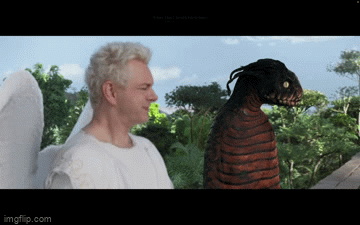
Aziraphale does a few confused double takes (which, sure, could be interpreted as ‘oh fuck it’s you’ but I am choosing to not see it like that :)) and then politely smiles and laughs at what Crowley says before asking for clarification. This is absolutely giving ‘awkward first meeting with a stranger’ energy and not ‘oh fuck it’s my old bestie who is now damned.’ This is not a face of recognition, even fearful or reluctant recognition:
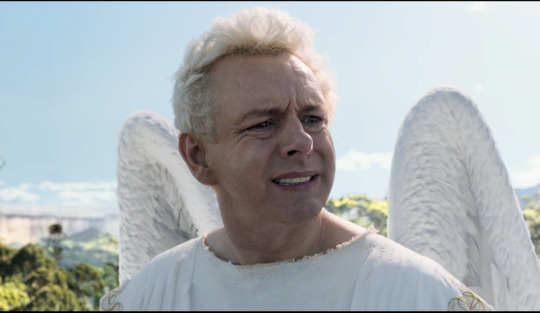
This is very much just giving ‘who the hell is this?’ Especially because it is then followed up with:

Aziraphale flat-out does not know who that is. He even closes his eyes for a second in what looks like confusion, as if he’s trying to remember. As if he’s trying to look where the furniture isn’t. And if I think he’s confusedly pursing his lips for a millisecond as if he wants to say a J name that’s my damn business.
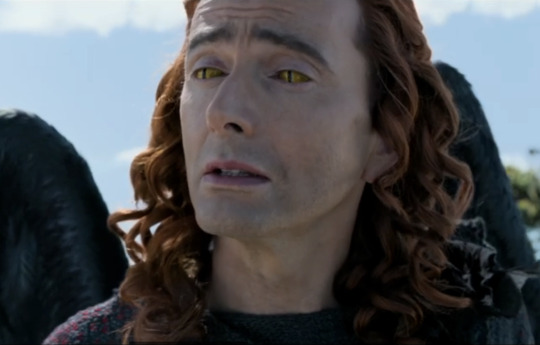
They look sorrowful. I don’t know how I didn’t catch it the first few times I watched the show. This is the face of someone who just slithered up to an old friend and started having a chat as if it was the most natural thing in the world only for that friend to have no idea who they are anymore. Even as their face moves into a smile, it’s not real.

Babygirl looks like he’s experiencing the most haunting, ancient melancholia behind those lovely snake eyes. It’s actually quite striking. David Tennent you are on my hit list.
Anyway Crowley then goes on to question the ineffable plan in a way that’s very reminiscent of ‘before the beginning,’ which I believe to be intentional because they remember, and Aziraphale doesn’t. So Crowley is thinking to himself that maybe Aziraphale’s memory could be jogged with familiar behaviour.
Crowley also goes on about the flaming sword, which I believe used to be theirs when they were the angel Jophiel, so the emphasis on it makes sense.
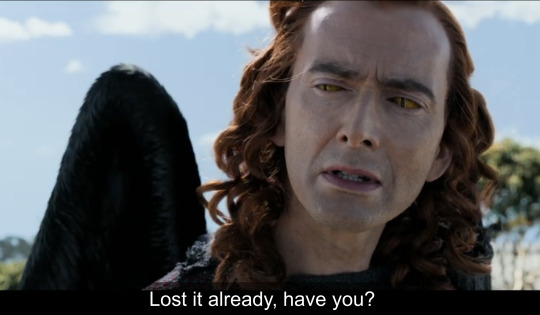
They really said “what the fuck did you do with my sword?” But then when Aziraphale says he gave it away we get the most genuine display of emotion from Crowley that he’s shown during this entire sequence.

He is impressed. He is remembering the angel who refused to exercise their celestial authority and got his memories stolen as a result. They are thinking there may still be hope after all.
Okay now let’s briefly talk about why I think Crowley does remember. I feel like this is a pretty easy one to get through as there are plenty of moments where Crowley references heaven and the fall in a very clear way, some of which I will drop right here:



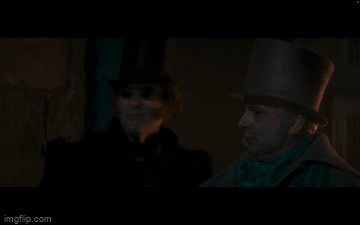
All well and good, but one big question still remains: if Crowley knows, why the fuck did he not tell Aziraphale in six thousand years?
Well… why did Elsa not tell Anna about her powers? I know this analogy is a little silly and trust me I’m losing my mind right now, but hear me out. Elsa doesn’t tell Anna about her powers because she thinks it's in her best interest not to know. She thinks that knowing will put Anna at risk and that she will be to blame for that risk. Now look back on Crowley and Aziraphale’s history, terrible communication aside, they don’t tell each other things because they both think that they can handle it on their own and they both don’t want the other to be in danger. They both consistently hide important and dangerous things from one another. For example:
Crowley didn’t tell Aziraphale about the Hell Hound for 11 years
Neither of them realised that both of their team of human agents were Shadwell’s men
Crowley didn’t tell Aziraphale the details of his execution
Aziraphale didn’t tell Crowley that he met Shax on the way home from Scotland
Crowley didn’t tell Aziraphale that he got dragged to hell and offered a promotion from Beelzebub
Crowley didn’t tell Aziraphale about The Book of Life threat
You get the point. It’s a pattern. And the details of the fall, stories from their distant past… these are lethal pieces of information. And we have to remember that both of them are essentially under constant surveillance. They never know when they’re truly alone or not, as we can also see with how much they side-step and rationalise their relationship away. They are both constantly terrified. Why would Crowley share information like this when they know how the acquisition of knowledge ended for the last group of angels? After all, Aziraphale wouldn’t like it in Hell.
Now there is also another very plausible explanation: Crowley is simply assuming that Aziraphale already does know and is following his perceived unspoken lead to never discuss it. Which again makes sense considering how fragile every aspect of their relationship is. It’s largely unspoken with a shared handbook of unspoken rules that they use to maintain the little bubble of companionship that they’re permitted to have. They have presumably never had a real conversation. So when would this ever realistically come up?
In conclusion, I need a lobotomy. But I want this to be true so badly as it does genuinely make sense in my sadly un-lobotomised little brain. As always, Neil Gaiman, I am in your walls.

38 notes
·
View notes
Text
Who was Hastur?
Hastur, in other literature, is "the king in yellow" from a play by Robert Chambers. "The King in Yellow" in those stories is a play that drives men mad from reading it, as well as a reference to a masked figure. I think this fits GO Hastur's behavior.
If we then track back the association with yellow, we find the angel Jophiel. From wikipedia:
The angel Jophiel "Beauty of God"), Zophiel ("God is my watchman" and Zuriel ("God is my rock"), is an archangel in Christian and Jewish angelology. Jophiel is associated with beauty and art.
Another name for Jophiel is Dina ("Judgement"). In the text, Jophiel/Dina is described as an angel of the seventh heaven, a Cabalistic guardian of the Torah (and wisdom itself), who taught 70 languages to souls at the dawn of creation. The Zohar lists Jophiel as a Great Angel Chief in charge of 53 legions who superintend Torah-readings on the Sabbath. Jophiel is said to be a companion to the angel Metatron.
Hastur's animal is the maggot, the inversion of beauty.
Are all the demons inversions of who they were as angels?
7 notes
·
View notes
Note
top 5 silmira characters? educate the masses my friend
so uh this got a LOT longer than i anticipated because im very normal about this series. anyways. this is all under the cut
megido and har birthclod


obvious answers. they're my blorbos so of course they're #1. they fucking hate each other <3
megido is far and beyond my favorite ofc. he dresses very classy but is self-motivated and ruthless. he has a rose motif. his idle animation is him shimmying. just look at him. he looks like if jet was a piece of shit (he already is, but not an ~Evil~ piece of shit)
he turns into a fucked up mutated version of himself if his brother dies bc har stabilizes the balance between their attributes so he becomes a weird looking dog version of himself. it's my favorite thing in the whole world.
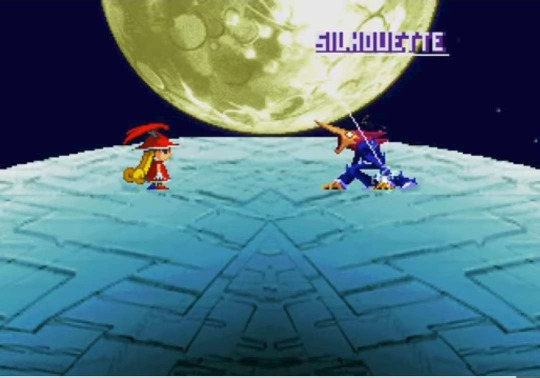
and har (or hal) is your main villain. he wants to rule the world as it is in spite of his brother who wants it to change back. he's a terrible dad (and yes, the guardian angels do call him dad(dy), it's true). doesn't care what sacrifices are made as long as he can accomplish what he wants to.
also he has muppet mouth sometimes. it's great.


2. zohar metatron / sandalphon

treasure literally gave us this bigender/genderfluid LEGEND and said "here's your rival, they can just switch between attributes on a whim like you" and then doesn't play it for laughs at all. they're like your jealous sibling who learned how to whistle before you did and then when you show them you can also whistle they're like NO FAIR I DID IT FIRST.
also, they can turn into this against their will.

it's supposedly very painful. they have no control over it and they don't even want to fight the protagonist at that point. but it does have the best boss music in the game.
youtube
3. faust and sara


i know i keep putting pairs together but I CAN'T HELP IT there's so many good characters in this game. also they're in literally the same area so i should be allowed this one
faust and sara are both hosts of their respective game shows in media city. faust is silhouette and his show revolves around shadow puppetry used as real objects to fight against shyna (including, i kid you not, a fucking tank). sara is mirage and her show is a gambling show with an enormous slot machine. faust gets very little screentime and dialogue but he's just. fucking cool? look at him??? i have no screenshots of his boss fight sadly but it's such a wicked concept. also at the end he turns into a bomb and fucking? explodes??? for the ratings to go up. insane.
sara gets a little more time and she's awesome. here's what she really looks like:

she doesn't like being touched (meaning you can't rob her for money for long, an actual thing you do in this game to get money) and she's so fucking snarky i love her. here's my favorite voice clip of hers, it plays when you finish her fight:
4. serah (featuring delia)

very close name with sara but don't be fooled, they are VERY different! giant fucking butterfly woman!!!
serah was the very first guardian angel, and although it didn't make her the messiah, it did make her a gigantic fucking butterfly. her japanese name is seraphim. you can only fight her under the specific instance that during the last fight with zohar the time limit runs out before you beat them, and then har deletes (re: kills) them in front of you and brings out serah as a more "worthy adversary". also, this is her unique boss theme:
youtube
i say featuring delia on the title because delia is connected to her and it'd feel kind of wrong to mention one and not the other. their relationship is only ever implied and not stated outright, but the implication is that they were (are?) married, especially before serah became a guardian angel. the title "your wife is an angel" is referential to this, and har even threatens delia that if he didn't comply he would hurt his precious serah. (in the original japanese, the translation for that part is that he would be forced to "forward" serah; it sounds like an email, but it's supposed to imply he'd put her at the front lines of battle). also, i just wanted to show off delia because he is the third nose guy in this game

you wanna know what his boss fight is? if you guessed "you fight him on his game show where he makes soup and you throw silhouettes into his soup to hurt him", you'd be correct!
5. dynamis
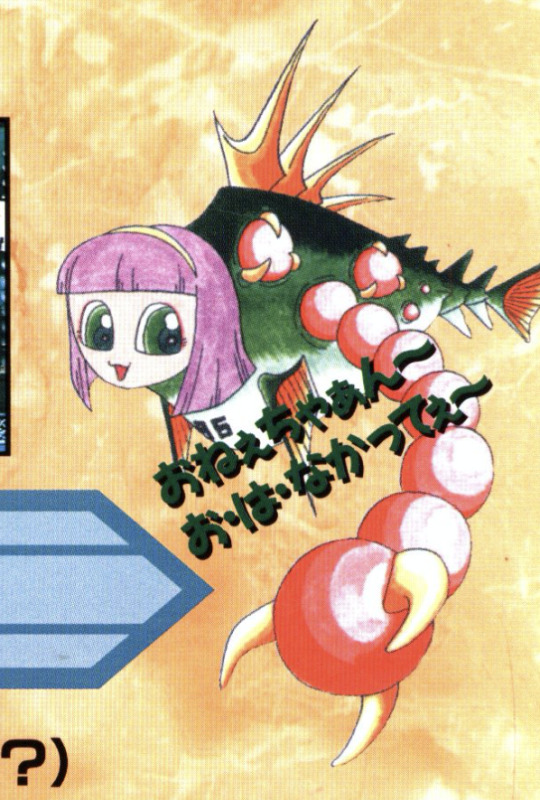
i have nothing to say. just look at her.

she just wants to sell you some flowers. pretty freakin' flowers. :)
HONORABLE MENTIONS:
pablo (a lad, honestly. look at him. absolutely harmless until he turns into a wolf.)

prinsdams (you never fight them because they eat you. also the one on the right has a surfer dude voice it's amazing. he calls shyna little dudette and everything.)

shyna nera shyna (how could i ever leave out our main girl?)


7 notes
·
View notes
Note
i don't believe i need to elaborate on why You are a bigender icon (you are bigender and also cool), but. zohar silhouettemirage requires explanation, being from an obscure sega saturn slash ps1 game that has a cool concept, mid-tier execution.
so. basically the entire lore of silhouete mirage is that every living being is either Silhouette (blue) or Mirage (red). you literally cannot naturally be both at once because silhouette and mirage powers repel each other to the point that you will not survive trying to harness both at once.
zohar (along with the player character, Shyna, and every other boss in the game) was part of an experiment to create a person who can harness both the powers of silhouette and mirage. as a result, zohar has two different forms (with different names, at that) that they can switch between at will: zohar metatron, their silhouette form, and zohar sandalphon, their mirage form. zohar is extremely powerful and proud of it, and because of this they are the rival of the player character, shyna.
now here’s the part where it gets bigender: their two forms have slightly different personalities and gender expression. metatron is more straight-up aggressive and masculine (and uses a sword), and sandalphon is more passive-aggressive and feminine (and uses a gun). (in general, they are kind-of an asshole but i love them for it they are so blorbo to me.)
in the japanese manuals and guidebooks, they aren’t referred to with pronouns (because that how standard japanese is) but in the game, every instance they are referred to with a pronoun or noun is gender-neutral—except for right after their introduction where shyna refers to them as something along the lines of “that man-and-woman” when “that person” would’ve worked just fine. in the english localisation, however, zohar is referred to with it/its in the manual and he/him in the like one instance they are ever referred to by a pronoun in the localisation. despite being referred to a he/him, they are referred to with gendered nouns based on their current form; metatron is “son”, and sandalphon is “daughter”.
too bad uh. the horrors happen to them. *opens my fix-it fic doc and adds another sentence*
also, the japanese-exclusive silhouette mirage guidebook has some funny little 1-panel comics. in one panel, shyna asks zohar how it is being both a man and a woman, and they’re like “meh, it’s alright” except they say it twice whilst switching between their forms—once in a more masculine way, and once in a more feminine way. in another panel, zohar is at a bathhouse, just standing there with a bucket and no idea if they should go in the men’s side or the women’s side.
other than that despite being obviously gender-non-conforming in whatever way their gender is never played or laughs or treated as anything weird or whatever. even the funny comic things in the guidebook are relatable. it’s so based.
i hope this fits in the askbox that's a lot of words
!!!!!!!!!
2 notes
·
View notes
Text
“This Enoch, whose flesh was turned to flame, his veins to fire, his eye-lashes to flashes of lightning, his eye-balls to flaming torches, and whom God placed on a throne next to the throne of glory, received after this heavenly transformation the name Metatron.”
“Metatron "the Youth", a title previously used in 3 Enoch, where it appears to mean "servant". It identifies him as the angel that led the people of Israel through the wilderness after their exodus from Egypt (again referring to Exodus 23:21), and describes him as a heavenly priest.
In the later Ecstatic Kabbalah, Metatron is a messianic figure.
The Zohar describes Metatron as the "King of the angels." and associates the concept of Metatron with that of the divine name Shaddai.”

#throwing up crying ecte ect ect ect on my knees ect ect ect ect#the last name also means divine breast and there's a dimension of feminity associated that you can find in early Peter texts#literally calling the knowledge as spiritual milk#the notion of androgyny is literally always present by the way
9 notes
·
View notes
Text
A Cabalá dos Hebreus
O texto abaixo é uma tradução de um pequeno livro do Célebre (ex) Rabino Convertido ao Catolicismo, David Paul Drach, contendo um resumo de alguns dos conceitos Básicos da Tradição do Sistema de Misticismo Judaico que ficou conhecido como Cabalá, e a Natureza Cristã de seus Mistérios.
"CAPÍTULO 1.
O que os Hebreus ensinam de sua Cabalá e de sua antiguidade; Principais Doutores dessa Ciência Esotérica; A Cabalá, que se transmitia, no início, oralmente, transmitida por escrito nos tempos posteriores; Livros que nos restam dessa redação; Os incrédulos procuram desnaturalizar-lhe o sentido.
§ 1. A Lei escrita e as duas leis orais, uma Legal, outra Mística ou Cabalística.
O termo Cabalá, que em hebraico quer dizer 'tradição recebida', קבלה, do verbo קבל (Kevel [receber]), indica, pelo próprio nome, que essa ciência é vista pelos rabinos como um ensinamento tradicional. Ela consiste, segundo esses doutores, em tradições que remontam aos tempos mais antigos; e, em essência, até Moisés, e mesmo até Adão. O legislador do povo hebreu – dizem eles – recebeu de Deus não apenas a Lei escrita, mas também a lei oral, isto é, sua interpretação tanto legal ou talmúdica quanto mística ou cabalística. Na verdade, jamais foi permitido aos hebreus explicar a palavra de Deus de outro modo que não de acordo com a tradição ensinada pelos antigos e, em última instância, nos casos duvidosos, senão segundo a decisão do supremo pontífice de cada época. Vede Deuteronômio 17,8.
Essas duas partes da lei oral não se compõem senão de tradições e de deduções lógicas a que deram lugar para determinar-lhe o sentido. É indubitável que nela foi introduzido, por assim dizer, muito dessas tradições apócrifas, ou desnaturadas, pelas quais os fariseus falseavam o sentido da Lei Santa, e que Nosso Senhor condenou nos termos mais severos. Mas aqui é o lugar de recordar a regra que dei em diversos pontos de minhas obras. Ei-la: toda tradição que ostenta o selo da verdadeira Religião, a qual – como tão bem o diz Santo Agostinho – remonta ao berço do gênero humano¹, é indubitavelmente autêntica. Por certo, não são da invenção dos rabinos as tradições que representam, na Divindade, Três Esplendores² Supremos, Distintos e, não obstante, Unidos Inseparavelmente numa Essência única da Unidade mais absoluta: as que estabelecem que o Redentor de Israel devia ser, ao mesmo tempo, verdadeiro Deus e verdadeiro homem;³ as que ensinam que o Messias se oferecera para tomar sobre si a expiação de todos os pecados dos homens;⁴ a que nos ensina que Shiloh, שילה, prometido pelo patriarca Jacó, é realmente o Messias⁵ – tudo isso que os doutores da Sinagoga moderna negam obstinadamente. Não é um rabino moderno que ousaria atribuir ao Zohar a explicação seguinte, confirmativa da do Evangelho, Mt 21,4-5: O 'simples⁶ montado num jumento', predito pelo Profeta Zacarias (9,9), é o Messias Filho de Davi.⁷
§ 2. Principais Doutores da Cabalá; O Zohar.
Aquele que ensinou a Cabalá mais brilhantemente e formou grande número de discípulos ilustres é o famoso Simeon-bar-Yochai, rabino do início do século II da nossa era. O dialeto em que se expressava é exatamente o dos judeus daquela época, o Siro-Jerusalemita, ao qual já se misturavam termos gregos e latinos. Ele ensinava, conforme ele mesmo nos informa, a tradição e a doutrina de mestres mais antigos que ele e atribui grande número, entre elas, ao Profeta Elias, a Moisés, chamado no Zohar de Pastor fiel, רעיא מהימנא (Reya Mahimana), e ao anjo Metatron. Seus discípulos e os discípulos destes se ocuparam, mais tarde, de escrever suas lições e de formar com elas um só corpo, que recebeu o nome de Zohar - זהר - isto é, 'Esplendor'. Essa redação, evidentemente, que durou vários séculos, pelo menos recebeu, durante grande lapso de tempo, novas adições, uma vez que ali se encontram mencionadas as duas partes do Talmud, a Mishná e a Guemará, muito posteriores,⁸ e se fala, inclusive, do falso profeta Maomé.⁹ Os historiadores judeus asseguram que só chegou até nós uma pequena parte dessa compilação. Rabi Ghedalia, na crônica intitulada שרשרת הקבלה (Shersheret HaKabbalah), 'Corrente da tradição', fol. Mihi, pág. 23, rosto, edição de Solkwo, escreve: 'Fiquei sabendo, por uma tradição oral, que essa composição é de tal forma volumosa que, se fosse encontrada na totalidade, formaria a carga de um camelo'.
§ 3. Tratados e livros complementares do Zohar.
O texto do Zohar, conforme o temos hoje, encerra diversos tratados aí inseridos sucessivamente em diferentes épocas. Entre eles, distinguem-se o ספר הבהיר ("Sepher HaBahir"), o 'Livro da Claridade'. É anterior ao nascimento de R. Simeon bar Yochai, pois é de autoria de R. Nehunya ben Hakanah, que floresceu trinta ou quarenta anos antes da Encarnação do Verbo. Em seguida, foram editados separadamente, para completar a compilação cabalística, 1º o תקוני הזהר ("Tikunei HaZohar") 'Os Complementos do Zohar'; 2º o זהר חדש ("Zohar Chadash"), o 'Zohar Novo'; 3º o Zohar do Cântico dos Cânticos, o de Ruth, e das Lamentações. Entre os livros cabalísticos, não podemos deixar de mencionar o ספר יצירה ("Sepher Yetzirah"), o 'Livro da Formação', e diversos outros livros antigos, parte dos quais não é mais encontrada ou se oculta em meio aos manuscritos de algumas bibliotecas. O comentário cabalístico do Pentateuco ילקוט ראובני ("Yalkut Rovni") fornece resumos de muitos desses livros atualmente perdidos. Inclui-se ainda no número dos principais livros cabalísticos o ספר רזיאל ("Sepher Raziel"), o 'Livro de Raziel'; mas este é preferentemente um tratado de teurgia.
§ 4. Regra para citar o Zohar.
Antes de prosseguir, penso que vem a propósito consignar aqui uma regra concernente à maneira de citar o Zohar. Esse livro, em todas as edições, divide-se em três partes mais ou menos iguais. A Primeira, sobre Gênesis; a Segunda, sobre Êxodo; a Terceira, sobre Levítico e os dois livros seguintes do Pentateuco. Distingue-se, em seguida, segundo as diversas edições, em Grande Zohar, זהר הגדול ("Zohar HaGedul"), e em Pequeno Zohar, זהר הקטון ("Zohar HaKatan"). A edição de Cremona, infólio, serve de modelo ao grande Zohar para a paginação. Ela é marcada pelos números das folhas e das colunas, à razão de duas por página. A edição de Lublin segue-a exatamente. O pequeno Zohar tem por modelo a edição de Mântua in-4º. Indicam-se tão somente as folhas, pois as páginas não são divididas em colunas. As três reimpressões de Amsterdã in-8º têm a paginação igual à desta última. Assim, a remissão às colunas, que facilita singularmente as pesquisas, se refere sempre ao grande Zohar. A edição de Sultzbach tem à margem a indicação das folhas e das colunas do Grande e do Pequeno Zohar.
§ 5.
(...)
§ 6.
(...)
§ 7.
(...)
§ 8.
(...)
CAPÍTULO 2
IDÉIA VERDADEIRA DA CABALÁ.
SEU USO NA SINAGOGA.
Vou expor o que é, de fato, a cabala judaica e submeto, sem temor, minhas provas à apreciação de todo homem de boa-fé e de bom senso. Será possível ver que, segundo a doutrina fundamental da Cabalá, o Universo é uma criação ex-nihilo do poder infinito de Deus.
Na realidade, toda ciência deve ter um fim prático. Ora, qual é o da Cabala?
O Zohar, principal código da Cabalá - parte 2ª, col. 362 - e depois dele todos os cabalistas respondem que seu fim é ensinar como devemos dirigir nossas intenções rogando a Deus; a qual esplendor e a qual atributo de Deus devemos recorrer principalmente em tal ou tal necessidade; [ 129 ] quais anjos podemos invocar para obter sua intercessão em determinadas circunstâncias; por quais meios nos devemos premunir contra a malignidade dos espíritos malfazejos, de que o ar está repleto. É precisamente para indicar com exatidão essas intenções, essas preces e essas fórmulas que o rabino Isaías Hurwitz, um dos mais eruditos cabalistas do século XVII, compôs um volumoso comentário cabalístico das orações usuais da sinagoga, sob o título (...), 'a porta do céu'. A consequência deriva disso naturalmente. A Cabalá fala de um Deus pessoal a quem devemos endereçar nossas preces, enquanto os panteístas se fazem Deus eles mesmos. Dizem com um filósofo coroado do Egito: 'meus Nilos são meus, fui eu que os fiz' (Ez 29,3).
Vi rabinos que, ouvindo pela primeira vez que a Cabalá continha os princípios do ateísmo, ficaram estupefatos. Acontece, muitas vezes, que, atacados de improviso por uma proposição estranha, despropositada, ficamos atônitos. Uma multidão de respostas apresenta-se confusamente, cada qual tão pressurosa de se manifestar primeiro que não sabemos por onde começar. Esses rabinos não podem deixar de exclamar: 'Mas isso não é possível! É um contrassenso, uma loucura. Como assim?! Nossos piedosos cabalistas de todos os séculos negando a existência de Deus! (...)!'.
Da difusão da ciência cabalística, os doutores da sinagoga moderna receiam um perigo de natureza totalmente contrária. Vários dentre eles excomungam os que publicam livros da Cabalá. Rabi Yehuda Arieh, conhecido como Leão de Módena, escreve, numa de suas obras intitulada (...), 'o Leão Rugidor': 'E eu conjeturo que Deus jamais perdoa os que fizeram imprimir semelhantes livros'. Na realidade, israelitas, ilustres tanto pela ciência quanto pela posição social, têm abraçado a Fé Católica levados tão somente pela leitura dos livros da Cabalá. Citei diversos deles em minha Harmonia, T. II, páginas XXXII-XXXV. Um discípulo do mesmo rabi Arié, Samuel ben Nahhmias, de rica família judia de Veneza, recebeu o Batismo na cidade natal em 22 de novembro de 1649, sob o nome Giuglio Morosini.
Esse Morosini é autor de uma volumosa e erudita obra em italiano intitulada Caminho da Fé mostrado aos Hebreus, Roma, imprensa da Propaganda, 1683, 2 vols. in 4º.
§ 1. A Emanação da Cabalá, e as Dez Sephiroth ou Esplendores; Os Três Esplendores Supremos
Os fautores do panteísmo imaginaram chamar em seu auxílio a Cabalá porque nela se fala, com frequência, de emanação. Abusando dessa expressão, enganaram grande número de pessoas incapazes de verificar as peças do processo. Pois bem! É precisamente essa doutrina de emanação que dá à Cabalá o caráter eminentemente Cristão que nenhum homem de boa-fé pode recusar reconhecê-lo aí. Nada mais fácil de mostrar.
A Cabalá distingue tudo o que é em quatro mundos, subordinados um ao outro: 1º) o Mundo Atzilútico (Emanativo); 2º) o Mundo Briático (Criativo); 3º) o Mundo Yetzirático (Formativo); 4º) o Mundo Assiático (Factivo, Factivus). Os três últimos, a partir do Mundo Criativo, são, conforme já o faz saber a denominação deste, criações ex nihilo da potência divina e, de modo nenhum, emanações da Essência de Deus. Os textos que acrescento mais adiante são formais a esse respeito.
A Emanação para, portanto, no primeiro mundo, que é o único incriado; ela aí permanece concentrada. Importa descrever, segundo a Cabalá, esse primeiro mundo. O Mundo Atzilútico compreende Dez Sephiroth (ספירות), isto é, Esplendores. A primeira é a coroa suprema (Kether Elyon), também chamada o Infinito (Ayn-Soph). Desta emana o segundo esplendor, chamado a Sabedoria (Chokhmah). Ela é Adão Primitivo (Adam Kadmon), assim denominado para ser diferençado do primeiro homem. Observamos, de imediato, que São Paulo chama esse esplendor encarnado Novissimus Adam - 1Cor 15,45.
Dele, com o concurso do esplendor supremo, cuja cooperação é necessária, emana o terceiro esplendor, chamado a Inteligência (Binah).
Tais são, conforme ensinam os cabalistas, os três Esplendores superiores, ou, melhor dizendo, Supremos (...), os únicos chamados Esplendores intelectuais (...). Embora distintos, não são senão uma Coroa Única (...); são Um, Um Absoluto, Unum Absolutum (...). Eis por que são representados por esses três círculos concêntricos;
(Imagem)
e por que se figura Deus Santo, Santo, Santo (Kadosh, Kadosh, Kadosh) por três Yods dispostos em triângulo equilateral e encerrados num círculo.
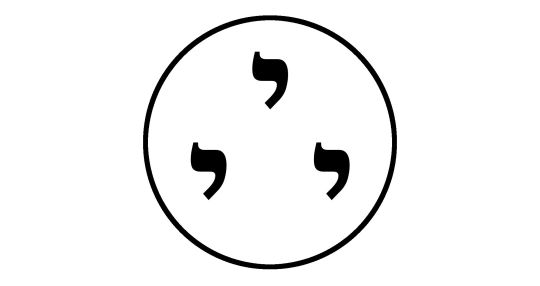
Vede Minha Harmonia, T. I, p. 309.
É preciso ser completamente cego para não se aperceber, ou de todo obstinado para não confessar, que esses três esplendores são as Pessoas da indivisível e Santíssima Trindade na Essência Divina, uma da unidade mais absoluta. A Cabalá enuncia essa verdade em termos idênticos aos da Teologia Católica, [ 130 ] como o veremos nos resumos fornecidos por mim mais adiante. Mas trarei aqui um texto interessante. Não o extraio de um cabalista judeu, mas do tratado 'De natura Deorum', de Cícero, livro I, § 21 (nº 28 na edição de Leipzig, in-4º): 'Parmênides imaginou algo que tem a figura de uma coroa. Ele chama stephane (στέφανη, Coroa) a um círculo contínuo, brilhante, de luz, que encerra o céu; é assim que chama Deus'. [ 131 ] Não estão aqui os três esplendores supremos que formam uma única coroa? E, observemo-lo, o primeiro esplendor encerra o todo em seu círculo contínuo sem solução. Cícero, nada compreendendo da sublime lição que o metafísico de Eleia repetia, provavelmente segundo uma tradição, acrescenta com a suficiência muito digna de um filósofo: 'Não poderia vir ao pensamento de ninguém que um círculo seja a figura da Divindade nem que tenha sentimento'. [ 132 ] Cícero não podia, porém, ignorar que os egípcios e outros povos antigos, famosos pela sabedoria, representavam o Deus supremo, eterno, infinito, por uma serpente enrolada em círculo, com a cauda na garganta; em termos de cabala, (Ayn-Soph), absque fine.
Os sete outros esplendores, emanados cada qual de tudo que os precede, são:
O Quarto, a Grandeza (Gedulah), também chamada Benignidade (Chesed).
O Quinto, a Força (Geburah), também chamado Rigor, estrita justiça (?).
O Sexto, a Beleza (Tiphereth).
O Sétimo, a Vitória, ou a Eternidade (Netzach).
O Oitavo, a Glória (Hod).
O Nono, o Fundamento, ou a Base (Yesod).
O Décimo, a Realeza (Malkuth).
Os sete Esplendores formam uma classe à parte, sob a denominação genérica de Conhecimento (Daat). O Conhecimento, diz R. Joseph Gikatilia, no tratado hrvh yrow (as portas da luz), é a maneira de ser das representações divinas que vêm após o hgyb (o Esplendor Inteligência), sem, todavia, formarem, por si mesmas, um esplendor, hryps, à parte.
§ 2. Os Sete Esplendores compreendidos sob a denominação "Conhecimento" ou Atributos Divinos.
É evidente, para todo espírito honesto, que, se os três primeiros esplendores, (Sephiroth), são Deus em Três Pessoas na ordem de procissão que nos ensina a Fé Católica, os sete Esplendores que se seguem são, conforme o declaram expressamente os cabalistas, os Atributos de Deus, [ 133 ] e, mais exatamente, Deus em seus atributos. Na realidade, eles compreendem todas as perfeições Divinas. Esses Esplendores são também emanações, pois os atributos Divinos são inseparáveis da Divindade e constituem uma unidade perfeita entre eles e em Deus.
Que os dez Esplendores – Sephiroth em hebraico – não são senão o conjunto – se é permitido empregar essa expressão – do Ser Supremo é o que prova ainda o Nome Divino atribuído a cada um deles, a saber:
O Primeiro é chamado (Ehyeh) - 'Eu Sou Aquele que É'.
O Segundo, ([Yah] abreviação do Nome Jehovah).
O Terceiro (Jehovah), pontuado das vogais do Nome Divino Elohim (...).
O Quarto (...) e, segundo outros, (El); Deus.
O Quinto, (...), Deus.
O Sexto, (...), Jehovah.
O Sétimo, (Jehovah Sabaoth), Jehovah das Potências.
O Oitavo, (...), Deus das Potências.
O Nono, (El Chai), Deus vivo.
O Décimo, (...), Adonai.
Eu disse que os Atributos Divinos são inerentes a Deus; é o que a Filosofia e a Teologia Cristã ensinam. Eis, em primeiro lugar, como se expressa o corifeu dos teólogos modernos, o R. P. Peronné: “Admitti nequit ulla realis distinctio inter Deum ejusque attributa, sive absoluta sive relativa, neque inter attributa absoluta ipsa. Si enim ejusmodi daretur distinctio, admitti in Deo deberet realis compositio atqui haec compositio in Deum cadere non potest, qui est omnino simplex; excludi igitur a Deo debet omnis realis distrinctio, sive inter Divinitatem ejusque attributa absoluta ac relativa, sive inter attributa absoluta ipsa” - 'Praelect. Theol., De Dei simplicitate', Prop. IV.
E, para que não se diga que essa filosofia de um Religioso se arrasta na trilha da Teologia, citarei a de um filósofo de todo insuspeito de excesso de zelo pelas idéias cristãs. 'Hoc primum tene', diz Bayle, 'nihil esse in Deo quod non sit Deus atque adeo attributa divina non esse qualitates seu perfectiones ab Essentia divina distinctas, nisi secundum nostrum concipiendi modum' - 'Systema totius philosophiae. Metaphysicae specialis', cap. III, art. 3.
Ao Evangelista, não lhe foi preciso mais que uma palavra para exprimir essa verdade, a saber, que os atributos de Deus estão essencialmente em Deus. 'Deus é Amor', disse ele - 1 João 4,16.
§ 3. Os Sete Espíritos de Apocalipse 1,4.
O discípulo bem-amado, assaz ditoso para repousar a cabeça sobre o Sagrado Coração de Jesus, recumbens in sinu Jesu, esgotou, nessa fonte Divina, o conhecimento dos mistérios mais profundos e mais temíveis. Não receio afirmar que vejo os dez esplendores claramente enunciados no célebre versículo de seu Apocalipse 1,4. 'Gratia vobis et pax ab eo qui est et qui erat et qui venturus est, et a septem Spiritus qui in conspectu throni ejus sunt.' Não repetirei que esses três tempos do verbo ser, pois 'venturus est', (...), equivalem, segundo o hebraico, à 'erit', são, se ouso me exprimir assim, a moeda do Nome Divino Jehovah, (...), que, pelos elementos, denota admiravelmente o Mistério da Santíssima Trindade. Comentaristas sérios já demonstraram que o Santo Apóstolo designa, por excelência, por esses três tempos do verbo, as Três Adoráveis Pessoas do Deus um; e eu mesmo desenvolvi prolixamente, em minha obra Harmonia, essa significação do Tetragrammaton. Eis aí, em primeiro lugar, os três Esplendores supremos.
Mas o que quero, sobretudo, estabelecer aqui é que os septem Spiritus desse versículo são, na realidade, os sete últimos esplendores, isto é, Deus em seus atributos absolutos.
A diversos comentaristas parece inadmissível a opinião dos que tomam esses sete espíritos por Anjos. Pois só Deus, com exclusão de toda criatura, por elevada que seja, inclusive na hierarquia celeste, tem o direito e o poder de conceder esse estado de Graça espiritual chamado 'Gratia et Pax', tradução verbal do hebraico (...). Esses dois termos bíblicos exprimem, com nitidez, a feliz união da alma com Deus, a graça, vaso precioso que, ai de nós!, é tão frágil nas mãos dos frágeis humanos.
O capítulo quinto distingue os sete espíritos dos anjos de tal modo que não seria possível os confundir. Vede os versículos 6 e 11. Em nenhum lugar do Apocalipse, veem-se os anjos chamados de espíritos. Essa saudação Gratia et Pax São Paulo apraz-se em repeti-la à testa de quase todas as suas epístolas, [ 134 ] tesouro da Teologia Cristã. Ora, o grande Apóstolo, como é de razão, não atribui esse dom celeste senão a Deus: 'Gratia et Pax a Deo Patre nostro et Domino nostro Jesu Christo'. Deve-se, pois, concluir que em nosso versículo do Apocalipse São João deseja às sete igrejas da Ásia a graça e a paz da alma da parte de tudo o que está em Deus, suas hipóstases e seus atributos.
A preposição 'et', (...), antes de 'a Septem Spiritus', não distingue esses espíritos do que precede. Grotius, com sua visão tão justa, já observou que há aqui a figura, tão comum entre os hebreus e os gregos, chamada (...) palavra por palavra, uma mesma coisa expressa de duas maneiras.
Ele explica em seu comentário que os sete espíritos são a Providência Divina, que se manifesta em diversas formas, chamada, mais adiante, cap. 5,6, os Olhos de Deus. 'Et oculos septem, qui sunt septem spiritus Dei, missi in omnem terram', diz São João. Grotius acrescenta: 'Et sic erit (...); optatur enin pax a Deo et septem Spiritibus, id est, a Deo per hos septem modos operante'. O Apóstolo do Verbo (In principio erat Verbum) declara, ao mesmo tempo, em seu Apocalipse, que o Verbo é Deus, e que, consequentemente, os Sete Espíritos lhe são inerentes, bem como o são a seu pai. Ele se exprime, nesse sentido, na quinta carta escrita por ordem de N. S. J. C.: “Haec dicit qui habet septem spiritus Deis”.
Um sábio jesuíta, o Padre Alcazar, autor de volumoso comentário do Apocalipse, [ 135 ] reconheceu perfeitamente que esses Sete Espíritos nada mais são, mesmo no sentido literal, que os Atributos Divinos absolutos. Eis aqui como Cornelius a Lapide resume sua exposição: 'Alcaçar per hosce septem spiritus accepit septem Dei virtutes, sive attributa in quibus consistit integra Providentiae perfectio. Porro haec dotes sunt in Deo, suntque reipsa ipse Deus: unde ab iis pacem et gratiam suis precatur Johannes. Haec ergo virtutes in Deo sunt immensae, nec ullum habent finem, nec limitem; ideoque vocantur Spiritus cum angelos Johannes in Apocalypsi angelos vocet, non spiritus'.
§ 4. As Sete Luzes Resplandescentes no Apocalipse 4,5 e os Sete Olhos de Jehovah em Zacarias IV,10.
Agora, o texto do Cap. 4, versículo 5, torna incontestável que os Sete Espíritos são precisamente os sete últimos Esplendores dos cabalistas. É dito aí, positivamente, que os Sete Espíritos são luzes resplandecentes e ressonantes dos focos que resplendem diante do Trono Celeste. 'Et de Throno procedebant fulgura et voces et tonitrua, et septem lampades ardentes, ante thronum, qui sunt Septem Spiritus Dei'. Todo esse versículo trata de uma única e mesma coisa, como foi dito anteriormente.
Essas luzes, atributos, modos, da Providência de Deus são chamadas em Zacarias, IV,10, os sete olhos de Jehovah, que passeiam por toda a terra.
'Septem ist oculi sunt Domini (hebraico, Jehovae, do Deus trin), Qui discurrunt in universum terram'. O Apóstolo São João, por sua vez, declara que esses olhos são os Espíritos de Deus. 'Tinha Ele (O Cordeiro Imolado) sete chifres e sete olhos que são os sete Espíritos de Deus, enviados por toda a terra' (Ap 5,6). Os cabalistas não deixam de dizer, segundo o texto citado de Zacarias, que os sete esplendores eram representados pelas sete luminárias do candelabro de ouro do templo; que essas luminárias representavam, do mesmo modo, os sete planetas, pela influência dos quais, segundo a crença dos rabinos, a Divina Providência se manifesta nesse mundo inferior (...). Enfim, o que acaba de confirmar que é esse o sentido dos Sete Espíritos de São João é o fato de o Apóstolo, no capítulo 5 do Apocalipse, depois de os ter atribuído ao Cordeiro, para nos repetir o 'Deus erat Verbum' de seu Evangelho, fazer do versículo 12 a precisa enumeração dos sete esplendores: 1. Virtus; 2. Divinitas; 3. Sapientia; 4. Fortitudo; 5. Honor; 6. Gloria; 7. Benedictio.
Vê-se pelo que precede que comentadores de grande autoridade quase acertaram no alvo, pois que reconheceram nesses espíritos os Atributos Divinos. Eichhorn, que, no século XVIII, se tornou ilustre pelos grandes trabalhos sobre a Bíblia, transpôs o último obstáculo em sua Introduction au N. T. No tomo I, p. 347, ele não hesita em declarar que os sete espíritos do Apocalipse pertencem ao sistema sephirótico (isto é, das Sephiroth, esplendores) da Cabala. 'Cabbalistisch sind', diz ele, 'die sieben Geister Gottes.'
Tal é, pois, o Mundo Atzilútico dos cabalistas, o único mundo incriado, isto é, Deus com seus atributos relativos (na qualidade de três Pessoas) e seus atributos absolutos (suas perfeições, na qualidade de Deus um). Essas primeiras Dez Sephiroth são, por conseguinte, um todo indivisível. 'Mistério dos mistérios do Ancião dos Dias', diz o Zohar, 'que não foi sequer confiado aos anjos das alturas.' (Zohar, parte 3ª, col. 243). É o 'Deus jamais visto', de São João - Cap. I, versículo 18. Nem sequer aos Anjos, dizem os Padres da Igreja; pois que se trata aqui do que os teólogos chamam a visão compreensiva.
§ 5. A Árvore Cabalística e Nolito Tangere.
A figura mais comum sob a qual são representadas as dez Sephiroth é esta aqui, conhecida como Árvore Cabalística.
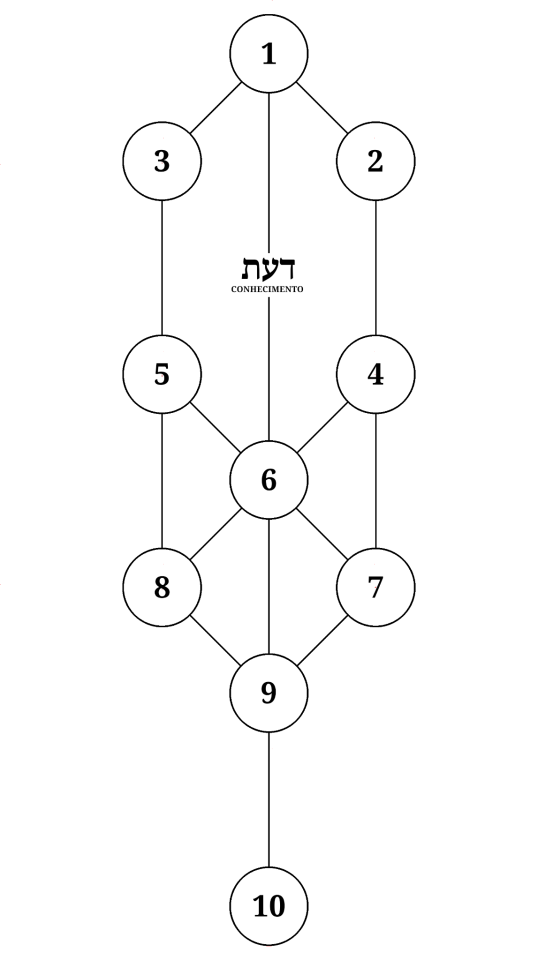
Os mundos diversos, as hierarquias de anjos, tanto bons quanto maus, esses chamados cascas (Kelipot), são igualmente diferençados em dez Sephiroth.
Cada Sephirah, por seu turno, tem também suas dez Sephiroth. Disso resulta um número ilimitado de árvores cabalísticas. É o que se chama 'o Pomar' - פרדס (Pardes). Eis a razão por que os cabalistas ensinam que aquele que se afoita a tirar desse sistema doutrinas errôneas 'destrói as plantas', (...); e que pretender perscrutar esses sublimes mistérios é introduzir-se no pomar (...)
O Talmud, tratado Ilhaghiga fol. 14 verso, nomeia quatro indivíduos que ousaram se introduzir no pomar. O primeiro foi vítima de morte súbita; o segundo, de alienação mental; o terceiro destruiu as plantas e, apesar da grande erudição em matéria da santa doutrina, tornou-se ímpio e morreu impenitente; o quarto retirou-se a tempo e não sofreu nenhum acidente.
Coloco aqui, de boa vontade, essas palavras do admirável livro da Imitação: 'Si non intelligis, nec capis, quae infra te sunt, quomodo comprehendes quae supra te sunt?'.
Os rabinos cabalistas da Idade Média não recuavam diante desses exemplos de castigo. Acontecia-lhes agitar questões tão curiosas quanto perigosas.
Eles perguntam entre outras coisas: Pois que Deus preenche todo espaço, em que lugar a Coroa suprema, causa das causas, pôde fazer emanar de si outra Sephirah, a primeira, por exemplo? É como se se perguntasse: que lugar a imensidade, a ubiquidade do Pai pôde dar ao Verbo engendrado?
Eles respondem que o Infinito operou sobre si mesmo uma espécie de contração - צמצום (Tzimtzum); retirou-Se em Si mesmo, sem que, não obstante, fosse o espaço privado de Sua Luz. Há que convir que é o mesmo que se introduzir no pomar da maneira mais temerária, e que, agitando semelhantes questões, se está bastante perto de destruir as Plantas. De resto, esses cabalistas eram muitíssimo rabinos para compreender que na Essência Divina Atzilútica a existência da Causa das causas e a geração ou procissão das causas, Causatorum, são coeternas, sem começo nem fim: 'nihil prius aut posterius'.
'Gloria sanctissimae eT individuae Trinitati, Patri et Filio et Spiritui Sancto; sicut erat in principio et nunc et semper, et in saecula saeculorum. Amen.'
_____
NOTAS
Sobre o autor.
[1]. Santo Agostinho;...
[2]. Drach: "Traduz-se Sephirah, ספירה, por Numeração e por Esplendor. Os resumos que apresento mais adiante provam que o último sentido é o único verdadeiro.
Vede os resumos que se seguem. Lembro aqui que em minha obra, De l'Harmonie, cito autoridades segundo as quais o grande mistério da Trindade deveria permanecer como segredo de apenas algumas personagens privilegiadas, (...), e só ser divulgado depois do advento do Messias."
[3]. C.f. Drach, "De l'Harmonie", T. I, págs. 70 á 107; T. II, págs. 387 á 485.
[4]. Drach:
"Zohar, 2ª parte, colunas 379, 380: 'O Messias se apresenta e brada:
Que todos os sofrimentos, todas as doenças (espirituais) de Israel caiam sobre mim! Todas, então, caem sobre Ele. E, se Ele não houvesse descarregado Israel para as tomar sobre si mesmo, não teria havido nenhum homem capaz de suportar as penas que Israel merecia pela transgressão da Lei Santa. É o que diz o Profeta (Is 53,5): 'Ele foi castigado por nossos crimes, e esmagado por nossas iniquidades'.
(N.T. - Texto original:
"בְּשַׁעֲתָא דְּאַמְרִין לֵיהּ לִמְשִׁיחָא צַעֲרָא דְּיִשְׂרָאֵל בְּגָלְוּתְהוֹן, וְאִינּוּן חַיָּיבַיָּא דִּי בְּהוֹן, דְּלָא מִסְתַּכְּלֵי לְמִנְדַּע לְמָארֵיהוֹן, אָרִים קָלָא וּבָכֵי, עַל אִינּוּן חַיָּיבִין דִּבְהוּ. הֲדָא הוּא דִכְתִיב, וְהוּא מְחוֹלָל מִפְּשָׁעֵינוּ מְדוּכָּא מֵעֲוֹנוֹתֵינוּ תַּיְיבִין אִינּוּן נִשְׁמָתִין וְקַיְימִין בְּאַתְרַיְיהוּ."
- "Vayakhel", 212a ["Zohar; Parashiot, KiTisa, Vayakhel", 1995, מכון דעת יוסף, página 211]).
Nova prova contra os rabinos de que esse capítulo trata do Messias.
O Midrash Yalkut sobre o cap. 60 de Isaías, no 359, transcreve longa passagem do livro antigo Peciqta-Rabba, que narra a conversa do Messias com Deus Pai. O Messias aceita com coração jubiloso a expiação dos pecados de todos os filhos de Adão, passados, presentes e por nascerem; e isso apesar do quadro apavorante que Deus lhe apresenta dessa dolorosa expiação.
(N.T. ...)
Não é esse o Messias esperado pelos judeus. Ele deve rejuntá-los de sua dispersão, devolver-lhes Jerusalém e aí reerguer o templo, depois de lhes haver submetido o restante das nações da terra. Digo o restante, pois elas serão, em grande parte, exterminadas. Há, atualmente, grande número de judeus que não têm muita fé no advento do filho de Davi e, dado o caso, não se preocuparia de o seguir na Palestina. Encontrando-me na maravilhosa quinta de um ricaço dessa nação, eu disse ao meu hospedeiro:
Se o Messias chegasse, abandonarias com desgosto essa bela propriedade. – 'Quando ele vier' - disse ele - 'suplicar-lhe-emos que conduza à terra santa os goyim (os Cristãos) e que nos deixe tranquilos na França, onde nos encontramos perfeitamente bem.'"
[5]. Drach;
"Zohar, 1ª parte, col. 504: 'O nome Shiloh, como é aqui ortografado, שילה - Gn 49,10 -, indica que o Nome Santo supremo da Divindade estará Nele. Tal é o mistério aqui anunciado'.
Rabbi Solomon Yarhhi explica igualmente esse nome por Messias, conforme as três paráfrases caldaicas: de Onkelos, de Yonathan-ben-Uziel e de Jerusalém.
Talmud tratado Sanhedrim, fol. 98 verso: 'Shiloh é o nome do Messias, pois é assim chamado na Profecia de Jacó'."
[6]. Drach;
"O Hebraico e a Vulgata de Zacarias trazem Pauper, e não Mansuetus.
São Justino cita o versículo, certamente de memória, como se ali fossem lidos os dois: χαὶ πραῢς χαὶ πτωχός."
[7]. Drach;
"O Zohar, 1ª parte, col. 505; 2ª parte, col. 171, e o Talmud, tratado Sanhedrin, fol. 98 rosto, citam o versículo de Zacarias como designando o Messias."
(...)
[8]. Drach;
"O autor do 'De Kabbala denudata', Knorr, Barão de Rosenroth, diz no tomo II, p. 5 do prefácio: 'Que nem a Gemara, nem qualquer livro talmúdico, faz menção a ele (isto é, o Zohar) em lugar nenhum'. Isso é um erro evidente. O Zohar menciona o Talmud e suas diversas divisões em vários lugares. Vede, entre outros, 1ª parte, col. 347; 2ª parte, col. 357; 3ª parte, col. 45, 49, 290, 540, 541. O próprio Knorr, no tomo I da versão latina do livro שערי אורה ("Shaarei Orah") do rabino José Gikatilia, refere uma passagem do Zohar em que se fala dos três tratados do Talmud intitulados Baba-qamma, Baba-metzia, Baba-batra.
Vede Kabbala denudata, t. I, p. 184 da 1ª parte.
Mais adiane, p. 7, Knorr escreve: 'Acrescente que mesmo contra Cristo em todo o livro (isto é, o Zohar) não é nem um pouco cuspido, como geralmente é feito nos escritos judaicos modernos'. Outro erro. No Zohar, 3ª parte, col. 546, Jesus, nomeado com todas as letras, é qualificado da maneira mais blasfema. Citei essa passagem conforme uma edição de Amsterdã em minha Harmonia, t. II, p. 27 da 'Notice sur la cabale des Hébreux'.
Em algumas edições, sobretudo nas submetidas à Censura Cristã, o lugar dessa passagem é deixado em branco, ou marcado por uma estrela, para advertir o leitor de que há palavras a completar.
Franck, que parece não ter estudado o Zohar senão na versão bastante suspeita de Rosenroth, repete esse erro deixando crer inteiramente que se certificou do fato. Às páginas 106 e 107 de seu 'De Kabbala', ele diz: '... e não se encontra aí (no Zohar) uma única vez o nome do Cristianismo ou o do seu Fundador'.
Como a obra do Barão alemão, Kabbala denudata, é o grande reservatório onde vão beber todos os que não podem ler o texto mesmo dos rabinos, acho necessário assinalar seus defeitos: 1º) Nos dois volumes, os textos em caracteres hebraicos estão estranhamente desfigurados por inúmeros erros tipográficos. 2º) A versão latina desses textos é, com frequência, inexata. 3º) As remissões ao Zohar são, na maior parte, mal indicadas. 4º) Não é raro encontrar aí o sentido dos textos alegados interrompido por alíneas que parecem dar início a uma nova frase, enquanto são apenas a continuação da frase começada na alínea precedente."
[9]. Zohar, 3ª parte, col. 546.
0 notes
Text
2

[picture belongs to their rightful owners]
Archangel Jophiel—
Jophiel is the Archangel of beauty, creativity and art.
According to the pseudepigraphal Revelation of Moses, another name for Jophiel is Dina (Hebrew: דִּינָה Dīnā, "Judgement").
In the text, Jophiel/Dina is described as an angel of the seventh heaven, a Cabalistic guardian of the Torah (and wisdom itself), who taught 70 languages to souls at the dawn of creation.
The Zohar lists her as a Great Angel Chief in charge of 53 legions who superintend Torah-readings on the Sabbath.[5] Jophiel is said to be a companion to the angel Metatron
1 note
·
View note
Text

genderfluid icon
25 notes
·
View notes
Photo

Zohar!
6 notes
·
View notes
Photo




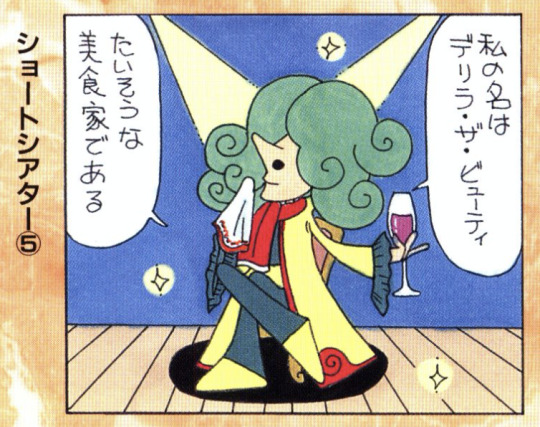





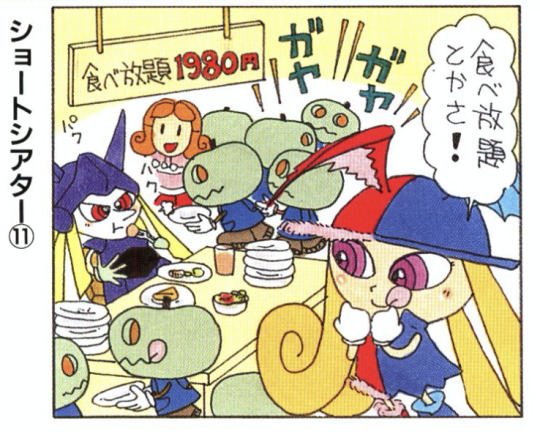

Mini comics from the guidebook of Silhouette Mirage
They seem really sweet, I’d love someone to be able to translate them-!
Scans from archive.org
32 notes
·
View notes
Note
Can you tell us a bit about Jophiel? She fascinates me.
Hello fierysword :) (I'm actually flattered that you've sent me an ask!)
So Jophiel. She's not one of the "seven" in my own practice, but I'd be more than happy to talk about an archangel 💫
Archangel Jophiel
Jophiel (Jofiel, Zophiel, Iophiel, Iofiel, Yofiel, and Yofiel) is the "beauty of God" also seen as the "Angel of Beauty". She is also regarded as a companion to Metatron
You can petition her or pray to her for:
Seeing beauty in things (such as God's creation)
Seeing beauty in God (and his holiness)
Self esteem (seeing yourself as the divine see you)
Creative inspiration
Helping your thought patterns and addictions
Joy in life
Transformation
Considering this, her domains could be conflated with Haniel's (Anael, joy of God. Harmony, poise and grace) and Zadkiel (Sachiel, angel of Mercy. Who can help with stress, anxiety etc.)
But looking to her domains, you can consider her an Archangel of gratitude, perspectives and inner thinking. A great archangel for shadow work in combination with other angels (like Zadkiel, who according to the Zohar, helps her and Michael battle evil), a very strong contender as a transformer of negative to positive thoughts
Additionally you can consider her domains to be:
Wisdom
Spiritual and religious reading
Knowledge
As Jewish tradition notes that she is the angel guarding the Tree of Knowledge with a flaming sword (sword is also attributed to Uriel, and being a wisdom archangel can be conflated with Uriel) and so she is a guardian of knowledge. She is also said to oversee Sabbath day Torah readings
She has also been written to be the angel of the seventh heaven and guardian of the Torah, who also taught 70 languages to souls at creation
As a patron angel you can call her:
Patron of Artists and Intellectuals as the angel who can bring beautiful inspiring thoughts (also attributed to Gabriel and Uriel)
Patron of Recovering People, as she can bring joy and light after darkness (also attributed to Zadkiel)
Patron of Balance (though typically attributed to Anael), as her association with bringing beauty is also associated with Feng Shui
Some systems may replace Jophiel with Raziel though places Jophiel is mentioned, other than what has been mentioned, includes:
Pseudo-Dionysus works
Kabbalah
Calendarium Naturale Magicum Perpetuum
The Veritable Clavicles of Solomon
Sixth and Seventh book of Moses
In terms of planetary correspondences, Agrippa attributes Jophiel to Saturn (Cassiel in ars paulina) and Paracelsus assigns to Jupiter (Zadkiel/Sachiel)
Robert Ambelain says Jophiel is in charge of this cherubim ("Prince of Cherubim"); Haziel, Aladiah, Lauviah, Hahaiah, Iezalel, Mehahel, Hariel, and Hakamiah
It is said that Jophiel's colour is yellow (though typically I have my own associations with colours and angels. This is just a fun fact). Though it can make sense with yellows association with illumination, the mind, the element of air and all associations to follow
Her symbol and element is fire which is for her light, illumination of knowledge and the flame that leads the way
Her day of the week is Sunday (shared with Michael).
Here's her sigil/seal you can use when working with her:
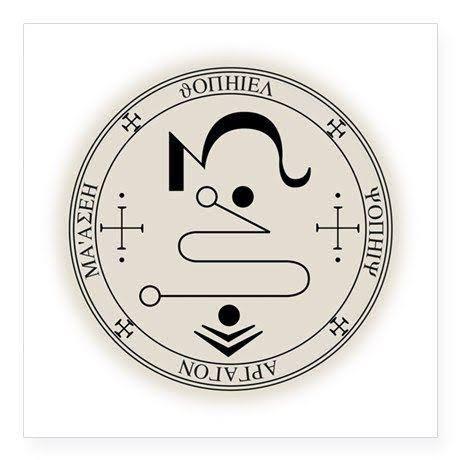
Here's a prayer you can say to her:
Dearest Archangel Jophiel, archangel of beauty and wisdom, please bless my creative endeavors.
Open my eyes that I may notice the beauty in the people around me as well in every part of Creation, including myself.
Empower me to maintain a clear mind even in times of chaos and make my mind orderly and serene. Inspire me to trust in God’s greater purpose for me and lend me the patience and the wisdom to recognize God’s beauty in every situation. — Amen
You can find my sources and further reading here:
https://unifycosmos.com/archangel-jophiel/#How_can_you_work_with_her
https://casaalhambra.com.au/blogs/the-archangels-and-their-sigils/the-archangels-their-sigils-gemstones
https://en.m.wikipedia.org/wiki/Jophiel
https://www.learnreligions.com/how-to-recognize-archangel-jophiel-124276
https://www.learnreligions.com/meet-archangel-jophiel-124094
https://www.theblackfeatherintuitive.com/archangel-jophiel/
https://www.ivyroses.com/Angels/Archangels/Archangel-Jophiel.php
@saintlyfawn anything to add?
Hope you enjoyed this information and learnt something new! And thank you for the ask. Feel free to send more
#qui.asks#qui.angels#archangels#angel work#angel magic#archangel jophiel#archangel magick#qui.devotion#angel witch#angel worker#sigils#angel witchcraft#ceremonial magic
207 notes
·
View notes
Text
Random tidbits, volume 3 (下)
[Linked the first part of these the other day and realized I didn’t respond to the second. Anyway, gonna rate your fanfic. In italics.] _________________________________________________________
The next two questions are more on the opinion/headcanon front. Or we can be honest and call this a “Rate this fanfiction premise” section.
3. Would the following narrative help justify Odin’s role in SMT4A?
Before events of SMT4 Maitreya approached Odin with an invitation to join Divine Powers and a plan to recreate the world. Odin refused. He saw that world was close to ending and for him it meant Ragnarok, something that he was prepared to meet with spear in hand even knowing that it would be his end. His brothers Vili and Ve didn’t share his outlook. In Maitreya’s suggestion they saw an opportunity to guide humans of the new world to re-conceptualize the Norse pantheon as truly immortal. They already once ruled in Odin’s absence. They could do so again, but for that Odin had to be absent. They lured him somewhere Heimdal wouldn’t spot them, “shattered” his identity, by separating his “thought” from his “memory”. Whether it was a part of the process or just to help with the disguise, each brother took one of Odin’s raven’s and assumed his identity. One set course back to Asgard to convince other Aesir to join, the other went to Maitreya to try and patch things up.
While they were occupied with that. Odin’s absence was noticed in Asgard. Nobody was really worried since everybody knew how Odin liked his excursions to Midgard, but Thor, ever the brash and impulsive one, headed out to look for him. A bit later, “Odin”-1 (disguised Vili or Ve, doesn’t matter which) returns and announces that they are joining the Divine Powers, but with the gossip of how categorically the Allfather refused Maitreya’s offer, everyone was a bit confused and suspicious of this sudden turnabout. As wise as Odin was, and as capricious as he could be, he usually wasn’t one to suddenly change his decision. Tension was rising. Aesir were getting more and more uneasy, “Odin”-1 was getting more and more forceful in his orders. Eventually it escalated to a civil war. Most Aesir vs. whatever would there be that is blindly loyal to Odin, no matter what (maybe Einherjar).
So that’s the setup. Thor finds Odin, organizes a couple of spectacular fights for him to witness that would bridge his “thought” and “memory”. Odin remembers everything, promises Flynn and the two other involved Hunters a place at Valhalla (completely sincerely), and departs for Asgard with Thor. “Odin”-2 starts acting more openly, now that Thor and Odin left Tokyo, SMT4A happens. Meanwhile, Odin and Thor reach Asgard and start dealing with “Odin”-1.
This whole story was born from two things: your article on SMT4A Odin, and (to me) baffling shortage of Norse bosses in SMT4A. If Odin from SMT4 is the same as the one in SMT4A, then Thor’s absence is glaring and confusing. Something must be off (assuming it isn’t the writing).
___________________________________________________________
This is probably WAY too complicated a (sub) scenario for SMT. One unspoken hallmark of SMT that the new games continue is that everything is seen from the protagonist’s perspective. So, you’d have to contrive a way for the protag to witness all the Asgard drama–which wouldn’t have much impact if they were told and not shown. But I do like expanding on the SMT4 Odin sidequest that’s more Norse than 4A, as you say. It’s a decent starting point for something like this.
___________________________________________________________
4. If I remember correctly, you were not fond of the justification for going after YHVH in SMT4A and of the idea that Zurvan is behind events of SMT:if… What if we combined the two scenarios?
YHVH being mostly his Judaic version works towards an apocalyptic scenario, in our hypothetical case, one that involves the end of the concept of time (I think it’s the one described in Zohar, correct me if I’m wrong). Zurvan, embodying among other things infinite time (his name with epithet Zurvan Akarana apparently means exactly that, ‘infinite time’) is not down for this direct existential threat to himself and so tries to make/find/empower a champion/Messiah/Godslayer/protagonist who (if player chooses this path) would side with Zurvan and slay YHVH… and whoever protects him… and Lucifer for thoroughness. After that we have two options.
Option 1: Zurvan takes YHVH’s place and Ahura Mazda assumes the role of Law’s top enforcer (basically takes over Merkabah/Metatron/Michael/Satan depending on the scenario).
Option 2: Ahura Mazda takes over YHVH, Zurvan returns to his preferred state of simply being a dispassionate embodiment of all space, time, matter and energy, doing sweet FA.
In both cases, Angra Mainyu takes charge of forces of Chaos.
___________________________________________________________
I’m in favor of any alternate Law gods. Zurvan, Melek Taus, even the tin can I just crushed (it was made… according to a plan) would probably be more interesting than YHVH and co. again.
In fact, don’t make it YHVH vs. Zurvan. It’ll be more interesting if it’s just Zurvan, Ahura Mazda, and Angra Mainyu. The time conflict is good, though. But like Judaism, Zoroastrianism does have a definite end of time, at least in terrestrial terms. I think Zurvan’s description of “infinite time” describes the god and not the timeline of history; the Kabbalah describes Yahweh similarly, as infinite in all things until the tzimtzum (contraction of his existence that allowed the lower existences to… exist).
So give Zurvan the Ein Sof role and Ahura Mazda as the more “comprehensible” Yahweh. Their time vs. practically anything poly as most have cyclical time. Does this improve 4A? Not sure about that but your idea is nonetheless an interesting thing to build off of!
7 notes
·
View notes